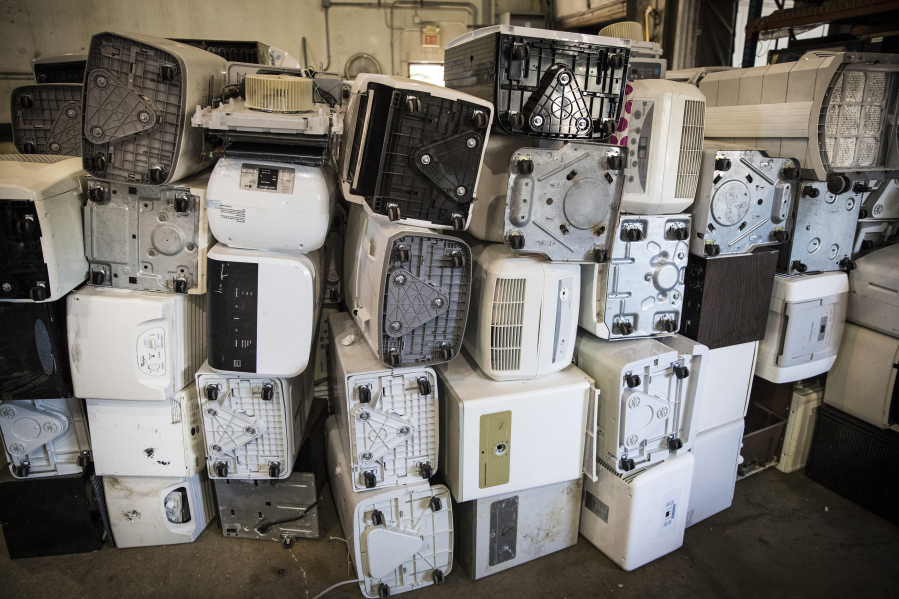MINNEAPOLIS — More consumers are discovering their dehumidifiers aren’t as trusty as those in basements past.
People who used to get decades of service from a dehumidifier are often getting only one to three summers before their machines quit. In recent years, millions of dehumidifiers have been recalled as fire hazards. And prematurely dead or recalled dehumidifiers are piling up at recycling agencies.
“We get thousands of them every year,” said Mike Larson, sales manager at J.R.’s Advanced Recyclers in suburban Minneapolis. “They’re hardly ever older than three years. Ten to 15 years ago, we didn’t see nearly as many and the ones we got were a lot older.”
J.R.’s, one of the Twin Cities’ largest recyclers, took in more than 6,500 dehumidifiers in the past year, he said. Nationally, about 2 million dehumidifiers were recycled in 2015, the Environmental Protection Agency reported. That’s nearly twice the number that were tossed each year from 2007 to 2014.
Dehumidifier Tips
• Call 1-866-853-2802 or 1-800-600-3055 or check www.cpsc.gov
• Operate a dehumidifier only in room temperatures above 65 degrees. Coils freezing up can cause overheating.
• Place a humidifier 6 inches or more from surrounding walls for adequate ventilation.
• Clean the filter as recommended by the manufacturer. Filters, if included, are often hidden behind the reservoir.
• Unplug the unit and vacuum coils periodically. If coils aren’t visible, check owner’s manual or go online for instructions.
• Don’t leave a dehumidifier running unattended when no one is home for extended periods. In Minnesota, most dehumidifiers can be stored unplugged in winter months. Humidity levels at 50 percent or less generally don’t require dehumidification. Hygrometers to measure humidity levels sell for less than $10.
• Keep windows closed when running a dehumidifier to avoid overtaxing the unit.
— John Ewoldt
John Zeien, co-owner of J.R.’s, blames cheaper materials. Like other appliance recyclers, he’s seeing more dehumidifiers that have been used for one to three years.
“We take them apart and they’re rusted,” he said. “There’s a metal bracket next to aluminum coils that caused it to corrode. Manufacturers are using less material. The whole product has been cheapened.”
Manufacturers also shipped twice as many new dehumidifiers in the past 13 years (23.2 million from 2003 to 2016) than they did from 1989 to 2002 (12.2 million), according to the Association of Home Appliance Manufacturers, a trade group.
Jill Notini, vice president of communications for the group, attributed the sales increase to the rising number of U.S. households and changing weather patterns. She said the group hasn’t heard complaints about the working life of dehumidifiers. “I get a lot of consumer phone calls, but none saying the dehumidifiers aren’t lasting as long,” Notini said.
The Star Tribune reached out to representatives from Whirlpool, as well as parent companies Gree and Midea, which manufacture Frigidaire, Kenmore, Soleus and many others but did not receive a response.
Dehumidifiers are considered a large appliance and cannot be placed in the trash because of the hydrochlorofluorocarbon refrigerants that are hazardous to the environment.
Jack Jackson, a service technician at A-Plus Appliance in St. Paul, which sells and accepts appliances for recycling, said he started noticing more frequent disposal of newer dehumidifiers about 15 years ago. A-Plus gets about five broken or recalled dehumidifiers every week. “They last a few years and then they’re shot,” he said. “You can’t fix them.”
Generally, consumers realize their humidifier is kaput when the unit starts making unusual noises or the reservoir quits collecting water. If the unit is connected to a hose running to a drain, the consumer may not notice until the house or basement starts to feel sticky and damp.
Rick Wigand of Isle, Minn., who has purchased units for his homes in Isle and the Twin Cities, said he’s concerned about rising amounts of environmentally hazardous refrigerants and raw materials wasted on appliances with such short life spans.
“In 10 years, I’ve bought four dehumidifiers, two that failed and two that were recalled, and none were more than a couple of years old,” he said. “They were all recommended by Consumer Reports, including two that were recalled.”
Fire danger worries Wigand the most. He said he’s scared about leaving a dehumidifier running in his house if he’s gone for a few days. Nearly 6 million have been recalled this year for fire danger.
Dehumidifier fires have caused one death and more than $19 million in property damage to 450 homes, according to the Consumer Products Safety Commission. More than 50 brands, including Frigidaire, Danby, GE and Kenmore, are part of recent recalls.
Sheboygan, Wis., battalion fire chief Robert Kocmoud said his crew responded to a house fire last December caused by a dehumidifier. Since then his department has asked all residents to check to see if their dehumidifier has been recalled. “The recall list is long,” he said.



